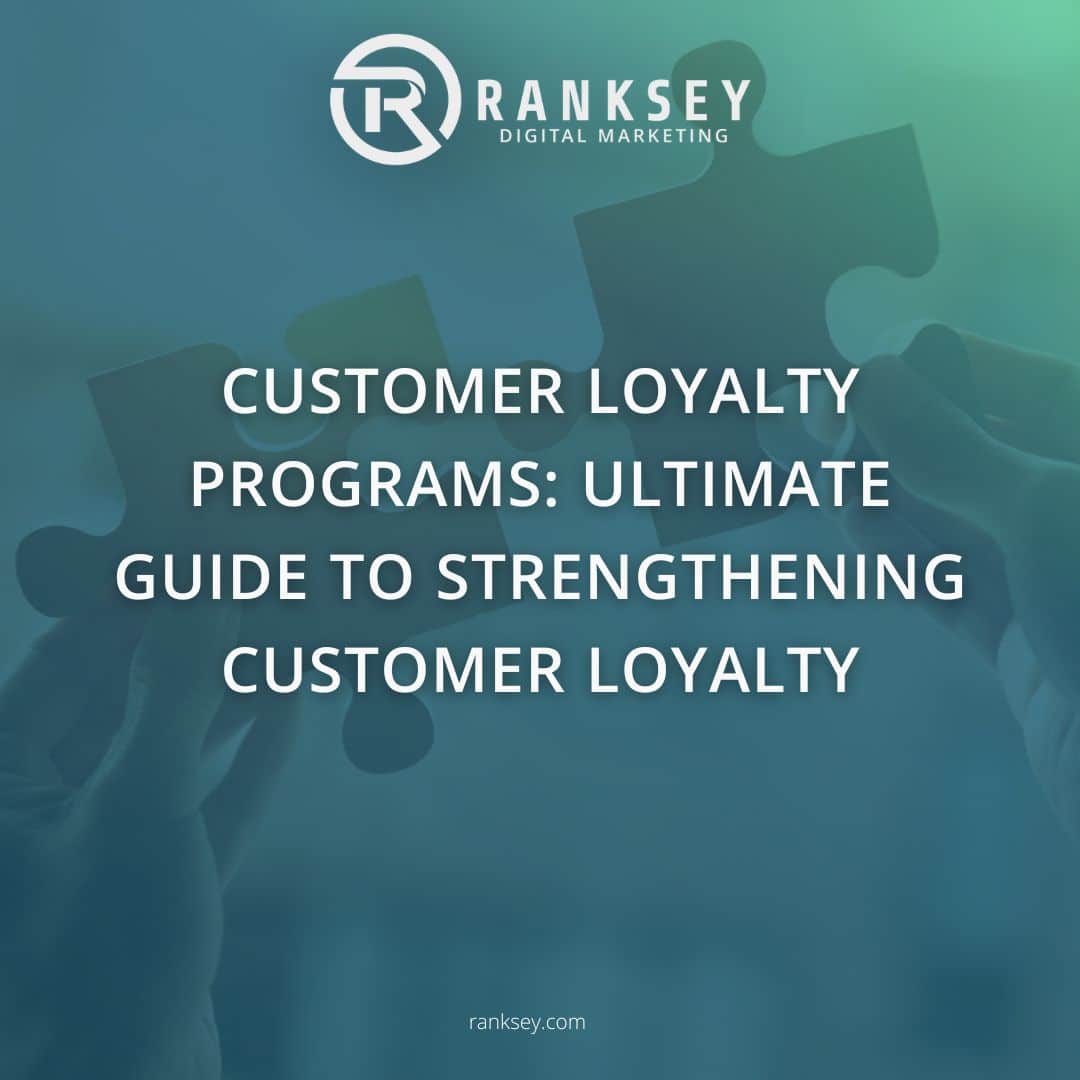Everyone wants their customers to be loyal to them, but building customer loyalty takes a lot of work. One of the first steps to building loyalty with your customers is to implement a customer loyalty program that rewards them for making repeat purchases from your store.
Customer loyalty programs are crucial for e-commerce brands because they strengthen customer relationships and retention. When online stores focus on customer loyalty, it can increase customer lifetime value, lower customer acquisition costs, and promote consistent revenue growth.
While traditional customer loyalty tactics like discounts and promotions may help you attract more consistent customers, creating a comprehensive customer loyalty program can maximize the value of your existing customers for a better return on investment.
In this post, we’ll cover everything you need to know about customer loyalty programs, how e-commerce brands can strengthen customer relationships, and how it can impact your bottom line.
What are customer loyalty programs?
Customer loyalty programs are programs where a brand’s customers receive an incentive for shopping at their online store, such as points, rewards, and discounts. The logic is simple: when you reward your customers for buying from you, they are incentivized to buy again in the future.
Why Customer Loyalty is Crucial for E-Commerce Brands
When e-commerce brands create reward programs for their customers, it can benefit their bottom line in many ways. One of the fundamental benefits of a customer reward program for e-commerce brands is repeat purchases. When your existing customers purchase more frequently from your store, your revenue, and your Customer Lifetime Value (CLV) will increase. This is important because revenue gained from existing customers has a much higher margin. CLV calculates how valuable your average customer is and implementing a customer loyalty program can help you maximize CLV, leading to higher profitability and long-term growth.
Speaking of customer loyalty, it’s important that you make it easy for your customers to get started. Be sure to invest in technology that makes loyalty program onboarding quick and secure.
Types of E-Commerce Loyalty Programs
There are multiple types of reward programs for customers that e-commerce brands should utilize. Some brands only use one customer loyalty program, while others use a combination. All loyalty programs for e-commerce are unique in how they create customer loyalty, and determining which is best for you depends on your brand’s goals.
Looking for specific examples on how to create a rewards program for your e-commerce brand? We’ll cover this next.
Point-Based Rewards to Incentive Future Spending
Point-based rewards are the most common customer loyalty programs in e-commerce. Once customers sign up, they receive points based on how much they spend with a brand. These points are then typically applied toward coupons and discounts on future purchases.
Here’s an example of a points-based loyalty program from Banana Republic:
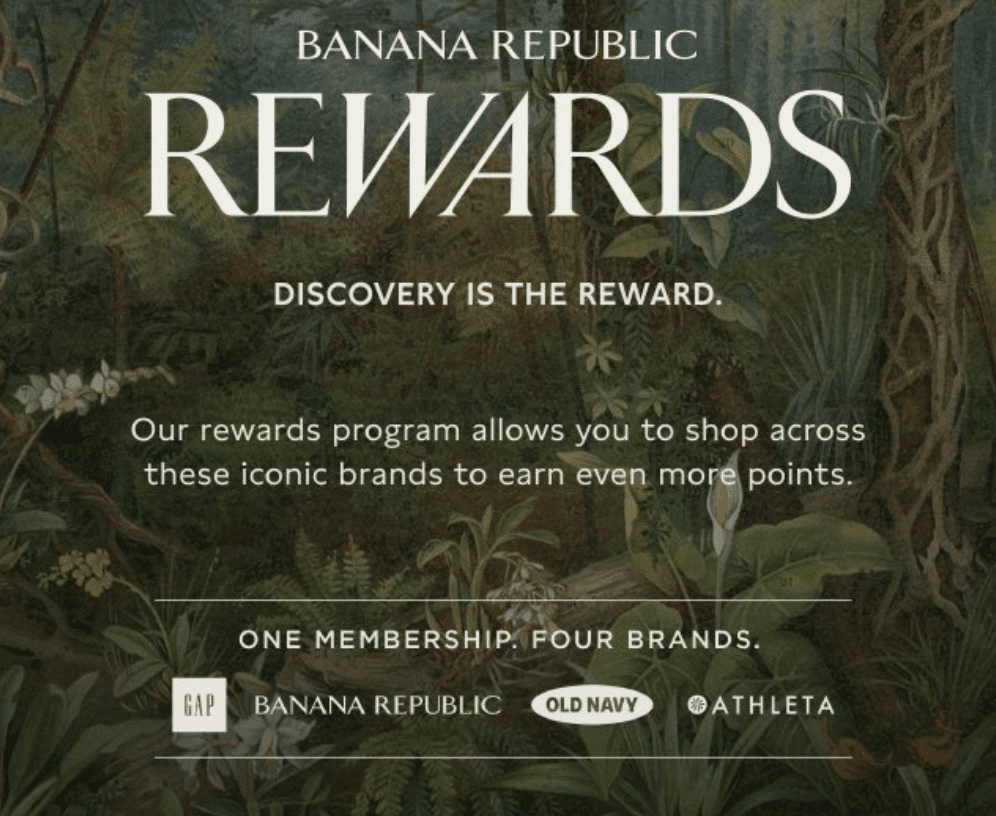
In this image, Banana Republic gives their customers 1 point for every dollar they spend. Once their customers’ points add up to 100, they receive $5 off their next purchase.
When customers receive customer loyalty discounts for future purchases, this increases the likelihood of them buying from your brand again. Even with discounts applied, if the purchase frequency of your customers increases, you are making up for the discounted price plus by increasing profitability.
Referral Programs to Attract New Target Customers
Another way for customers to get points and rewards with e-commerce customer loyalty programs is through referrals or word-of-mouth. This works by encouraging your existing customers to refer their family and friends to your store with some incentives for both the original customer and the customer they refer to you.
Here’s an example of referral e-commerce customer loyalty programs from Gousto:
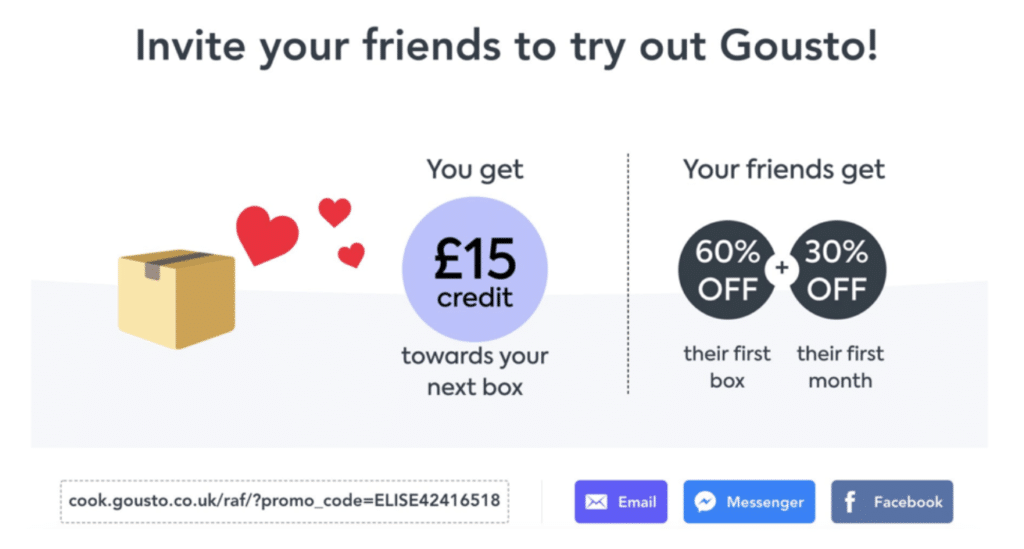
In this image, Gousto offers a $15 credit for their customers towards their next food subscription box if they refer Gousto to a friend. Gousto also displays additional benefits the referred customer receives, including 60% off their first box and 30% off their first month.
When existing customers refer your brand to people they know, you can acquire new customers without paid advertising or high acquisition costs. Additionally, since these new customers are referrals, they’re more likely to become long-term customers because someone they know is already a loyal customer of your brand and they have likely told their family and friends about their positive shopping experiences with your brand.
Referral programs are an easy way to increase customer loyalty by improving and tracking word-of-mouth marketing within your target audience with cheaper acquisition costs.
Paid Memberships to Reward Repeat Customers
A paid membership program is the least common customer loyalty program for e-commerce brands, but it can be an effective option for larger companies with a loyal customer base. Paid membership pricing can vary based on the brand such as a monthly, yearly, or initial one-time payment to become a member.
Some examples of paid membership perks for online stores are:
- Early product launch emails
- Pre-release access for new products
- Exclusive discounts offered to members versus non-members
Here’s an example of paid memberships in e-commerce customer loyalty programs from REI:
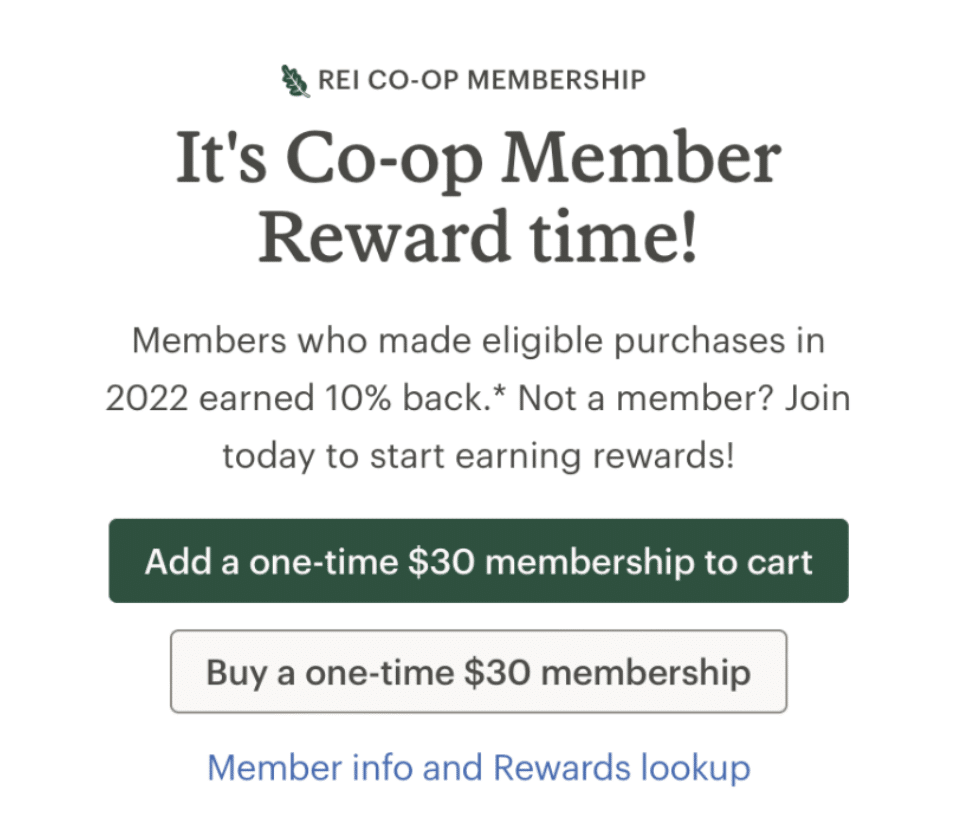
In this image, REI markets its co-op membership program by displaying the benefits of joining with multiple membership options available. REI also offers a one-time membership for potential customers who want to try it before they buy. By showcasing both a one-time and annual co-op membership, REI increases paid membership sign-ups because it provides a high value offer at a low risk.
Rewarding paid members is an effective way for e-commerce brands to increase customer loyalty because it provides value for their customers’ investments. When existing customers feel an e-commerce brand cares and reward them for paying for their products, it feels like a valuable return on investment. Providing valuable solutions to current customers through paid memberships can increase customer lifetime value significantly. Similar to Costco’s membership to shop at their store, or Amazon’s Prime membership, customers will often spend more because they feel the need to save more in order to justify their membership investment.
Learn how to increase customer lifetime value in e-commerce on Ranksey’s podcast, “E-Commerce: Secrets to Scale”.
Tier-Based Customer Loyalty Programs to Structure Rewards
Tier-based reward programs for customers are like point-based rewards because they both structure rewards based on how much a customer spends. However, with tier-based rewards, customers are incentivized to spend more to unlock additional benefits and it’s based on total spend in addition to rewards points.
Here’s an example of a tier-based e-commerce customer loyalty program from Dr. Squatch:
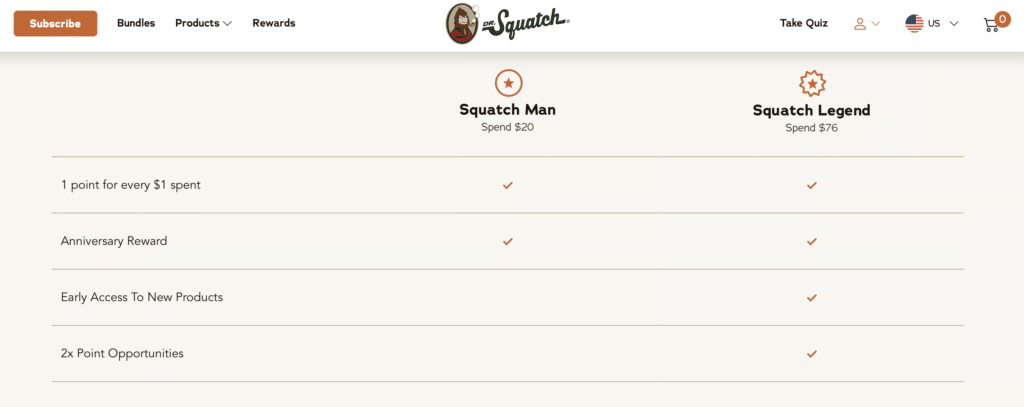
In this image, Dr. Squatch displays and compares their two customer loyalty program tiers, Squatch Man and Squatch Legend. Each tier offers its own customer loyalty benefits and shows the value of each. By showcasing the differences between Squatch Man and Squatch Legend tier rewards, Dr. Squatch increases customer lifetime value by incentivizing shoppers to spend more in order to gain more value in return.
Whether you’re using tier-based or points-based rewards, shoppers are more likely to become repeat customers if you reward or incentivize them with high-value benefits or offers for spending more.
How to Measure Customer Loyalty in E-Commerce
When you implement a customer loyalty program, your goal is to build some loyalty with your customers. Tracking the right metrics to measure their success is essential to know whether or not you’re making an impact. Below we’ll break down the metrics required to measure customer loyalty program success in e-commerce.
Purchase Frequency
Customer loyalty programs aim to increase customer retention and purchase frequency. To measure your customer loyalty program’s success, you must track purchase frequency and compare between members and non-members. Take it a step further and compare the purchase frequency of customers before and after they joined your loyalty program. By segmenting purchase frequency data between members and non-members, you can measure the impact that your loyalty program is having on your purchase frequency.
Purchase Frequency for Customer Loyalty Program Members and Non-Members
Understanding the impact your loyalty program has on your customers will allow you to strategize and improve your customer loyalty programs. For example, if your online store has a higher purchase frequency rate from non-members, you can shift strategies to focus on them more — such as higher discounts for new email signs ups since they’re buying less often than members.
Additionally, you should track if their purchase frequency increases after someone signs up for their customer loyalty program. This will clearly illustrate if the customer loyalty program successfully incentivizes new members to spend more. If purchase frequency increases for new members, the program successfully retains them while turning them into repeat customers. In contrast, if purchase frequency decreases for new members, you might want to rethink the benefits that you’re providing to your customers and implement further incentives that will drive more frequent shopping.
Referral Transactions
If you are running a referral-based loyalty program, you need to track transactions from referrals in order to measure the success of your program. Customers who refer a brand to others can create another level of value for e-commerce brands. According to SEMrush, word-of-mouth marketing is five times more likely to result in a transaction than paid advertising.
If your brand is able to identify which customers are referring a lot of revenue to your store, you can strategize your referral program to satisfy them even more so they continue to share your brand in the future. An initial investment like extra rewards or discounts to referral customers are crucial because rewards and discounts don’t even come close to being as expensive as acquiring a new customer through paid ads.
Learn how to increase word-of-mouth sales on Ranksey’s podcast, “E-Commerce Secrets to Scale”.
Net Promoter Score
Net promoter score (NPS) is an essential metric to track because it measures how happy your customers are and how likely they are to recommend your brand to a friend. To calculate NPS, create an online survey that asks your customers how likely they are to recommend your brand on a scale of 1-10.
Net promoter score data improves referrals by asking customers who score your business high to promote your brand. If a customer responds that they are likely to recommend your brand to someone they know, you should prompt them with an incentive to do so. It’s a win-win because they already love your brand and they receive a reward for spreading the word.
Understanding and tracking NPS data is essential for brands that want to measure the impact of their loyalty programs because you can gain insight into your current customer experience and identify opportunities for improvement. Improving your customer experience has a profound effect on how loyal your customers are to your brand.
Strengthen Your Customer Loyalty Programs with Customer Value Optimization
E-Commerce customer loyalty programs can significantly impact your customer lifetime value and customer retention by providing additional value to customers that already shop at your store. However, implementing a reward program is only one tactic of many that can be used to increase your Customer Lifetime Value (CLV). While employing loyalty programs can provide you with an incremental improvement to CLV, there are so many other ways you can be working towards achieving a higher CLV.
If you’d like to maximize your CLV, check out our Customer Value Optimization services or request a Free CLV Audit where we can show you some actionable strategies to optimize CLV, free of charge.



